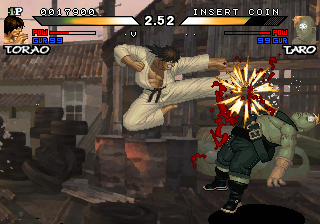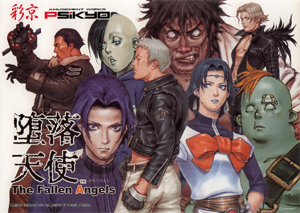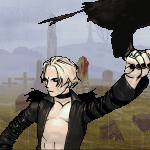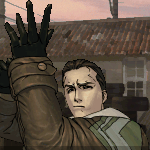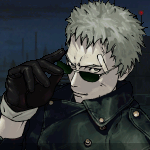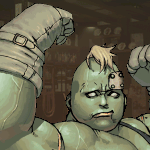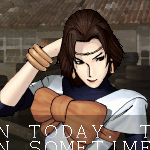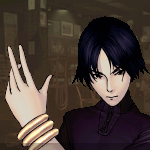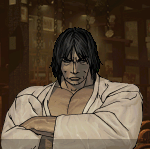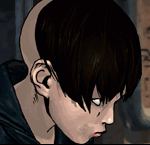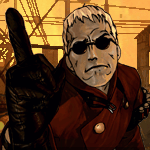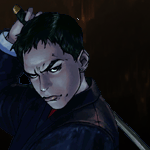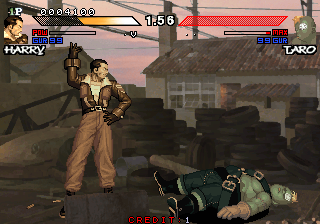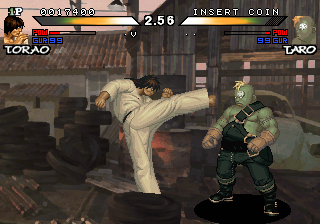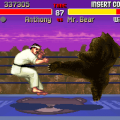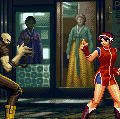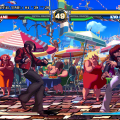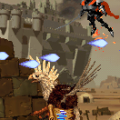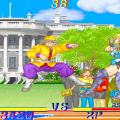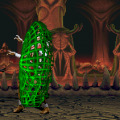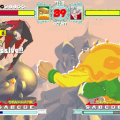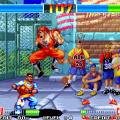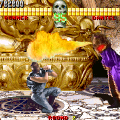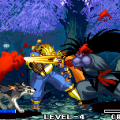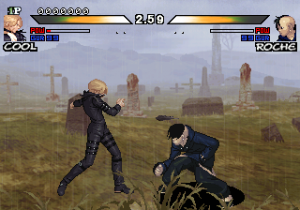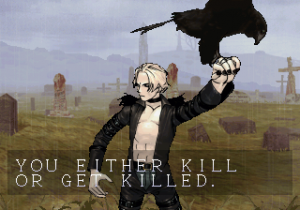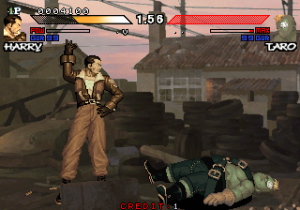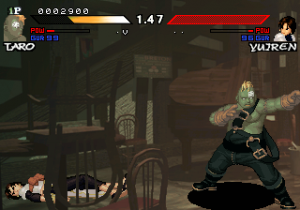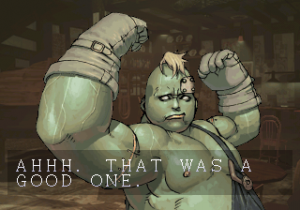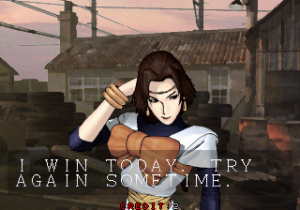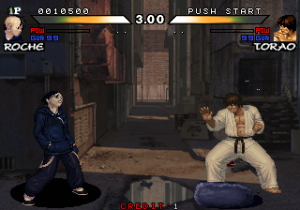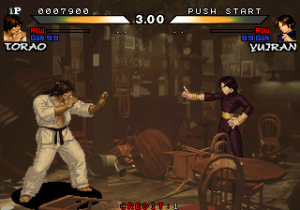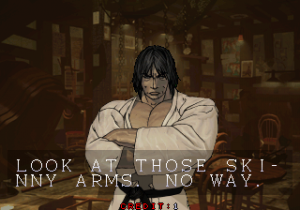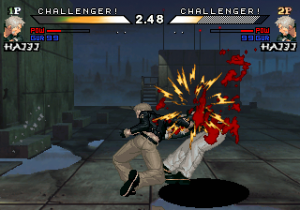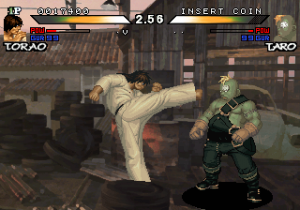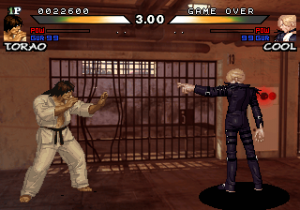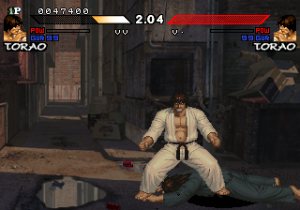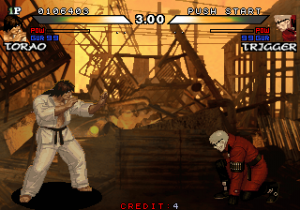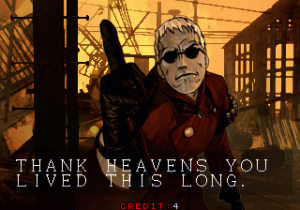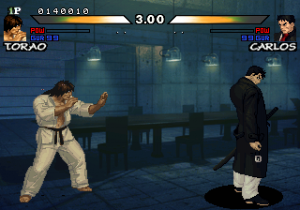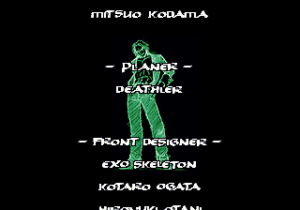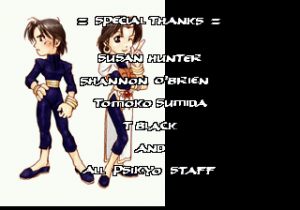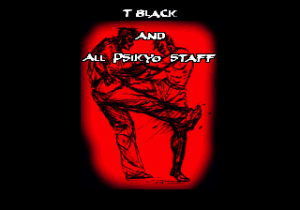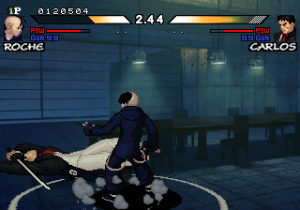When Psikyo decided they wanted to make another fighting game, they wisely decided to not connect it in any way or form to Battle K-Road. However, they didn’t want to make it like any other fighter in either gameplay or atmosphere, and when they would do so four years later, the result would culminate in a criminally overlooked fighter that stands head and shoulders above their first effort. Daraku Tenshi (which literally translated into The Fallen Angels for its American release) is not the most diverse or well-made fighter to ever exist, but it offers a fantastic dark and gritty atmosphere, with decidedly unique characters, bearing relatively realistic and straightforward move lists with nary a “hadoken” in sight. It also has a vague plot, unlike BKR which was just a straightforward fighting tournament with a bear as the champ. It involves a massive earthquake tearing a nameless city to shreds, which may have either been a former Japanese city or Los Angeles (the latter would make sense considering the prominence of “Angels” in the title).
The prologue goes as follows:
The earthquake that struck the city at 7:13 a.m. on February 10, 2000, measured 7 on the Richter scale.
The veneer of peace that had been maintained in the city’s streets by total information control suddenly vanished, and the computer-controlled concrete jungle stopped functioning.
A major shift in the Earth’s crust had severed the city from its surrounding landform, leaving it an island with virtually no outside contact. Money-crazed inhabitants soon lashed out for the city’s remaining but useless vestiges of power, preaching salvation while hiding their wicked motives.
Sex, crime and drugs ruled the streets, as the city began to decay. Ironically, they called the wretched remains of their city ‘Eden- the last paradise.’
It is now a decade later. The year is 2010.
Thus, punks, killers and weirdoes, all fight to survive on the streets of Eden. There’s really not much else for tangible plot details, though they apparently want a piece of a powerful crime lord named Carlos. The roster is admittedly short at a mere eight playable characters, plus two broken bosses. Whereas most games in 1998 had anywhere from 20 to 30 or more characters for play, Daraku Tenshi seems to be just a bit behind the times with its single-digit selection. Regardless, if not an extensive cast, it is at least a diverse one with some interesting designs that look somewhat reminiscent of SNK’s games, only darker and less colorful. In fact, artist Tomoyuki Kotani (a.k.a. styleos) worked on the character designs here before moving on to SNK and contributing to the King of Fighters series, most notably KoF99‘s new heroes, K’ and Maxima (to whom two characters in this game bear a semblance). The ragtag band of brawlers follows thus:
Characters
Cool
This young punk looks and dresses similar to K’ from the King of Fighters series, but staying true to the more realistic character move sets, he isn’t able to generate fire from thin air. As one of the very few characters in the game who can toss projectiles (feathers, to wit), Cool isn’t too incredibly powerful, but he makes up in speed and guile. Speaking of guile, he also has a move akin to Guile’s Flash Kick!
Harry Ness
Bearing a bit of parity to another SNK fighter (Maxima, the cyborg companion of K’), Harry is the game’s requisite hulk. He has crushing special throw attacks and is one of the rare projectile users aside from Cool, bearing explosive missiles in his wrists. Interestingly enough, he can only use six missiles per round, and one of his super attacks unloads every last one into his opponent point-blank!
Haiji Mibu
Yet another SNK-esque character amongst the cast, Haiji looks an awful lot like Yashiro Nanakase, but has moves and a personality akin to Ikari Warriors‘ Ralf Jones. He is one of the harder hitters of the roster who also yells very loudly with all of his specials. His totally-not-Ralf’s Galactica-Phantom charge-punch can deck off more than half of the opponent’s life, if he charges it long enough.
Taro
Doubtlessly the most inexplicably bizarre cast member, Taro appears to be a hillbilly Frankenstein’s monster. His green flesh is similar to everyone’s favorite Capcom jungle beast, Blanka, but he has no electricity, simply a lot of bulk combined with surprising agility. He has a three-part special which hurts more than most super attacks, but he is slow and lumbering as all get-out.
Yuiran
A slender and fit assassin who is the only female fighter amongst the roster. Her slim frame belies her status as the game’s main grappler, with several bone-breaking unblockable techniques that are somewhat awkwardly performed through charge motions. She is one of the harder characters to play properly, but has a lot of cool animations to her attacks. Yuiran also just so happens to be the sister of…
Yuiren
Yuiran’s honest-to-goodness brother and a decidedly more fanciful dresser than his sister. Pulling a Bridget several years before Bridget ever existed, Yuiren is more strike-oriented than Yuiran, and is one of the faster characters with several graceful but deadly attacks in his arsenal. His move trajectories can be awkward, but certainly not as awkward as fighting in such elaborate garb.
Torao Onigawara
As mentioned before with Battle K-Road‘s karate guys, every fighting game needs a gi-clad shoto with a predictable Ryu/Ken-esque move set. Torao is nothing like a typical shoto. He looks like a hobo and even has flies to match, but he hits hard with down-to-earth karate punch assaults, jump-kicks, counterattacks, and even a poke of death. I’d wager his breath could make a good projectile too.
Ruccio Roche
The obligatory kid character of the bunch, but arguably the most dangerous character in the game despite his small form. A professional assassin who says absolutely nothing (reading only “…..” for his win quotes), this little murderer breaks necks, slits throats, stomps bodies out of the air, slashes with his hands, and does a bunch of other nasty stuff.
Trigger
The totally unfair sub-boss who brings guns to a fist fight. Clad in shades, a blood-red coat, and packing dual pistols, Trigger was hired by Carlos to choke the city sewers with your corpse. His bullets fly out faster than Cool’s feathers and are unlimited, unlike Harry’s missiles. Even if you get in close, he’s not too shabby a melee fighter either, worthy for an honorary spot in SNK’s hall of cheapness.
Carlos
The, also, unfair final boss who bears a friggin’ sword. Not much is known about him except that he’s apparently a ruthless and powerful crime lord whom everyone wants dead. He has very few moves, but he doesn’t need too many when his katana grants him unfair power. His sole super attack can chop off about half of your life bar. While also rather SNK-level cheap, he is definitely beatable.
Daraku Tenshi plays like most games of its time, with motion including double-tap forward and backward dashes along with down-to-up high jumps in employ. You have your basic light punch, light kick, heavy punch, and heavy kick, and can prep up for an even more powerful punch or kick with a stance switch by pressing both kicks simultaneously. Pressing both punches invokes a dodge which can bypass most attacks if timed right, and pressing any attack while dodging tosses out a counterattack to punish careless opponents. You can also recover quickly by pressing both punches as you hit the ground while falling from taking a hard attack. Both fighters get a numerical guard gauge that drops from the maximum of 99 whenever they block any attack, and they are left briefly vulnerable if it depletes to 0, though it returns to 99 after a guard crush. Nothing here is too out of the ordinary from any other fighters, but the obligatory implementation of special moves that are unique to each character is a bit different than per usual.
If there’s any possible link that Daraku Tenshi contains with Battle K-Road, it’s the relative amount of realism that’s maintained for everyone’s move set. We’re used to seeing projectiles materialize from hands, burly men leaping twenty feet into the air to slam their opponent hard onto the floor, and entire bodies fly through the air in their best Superman imitation, to plow through their adversary. Moves in DT are mundane in comparison, with no flashy visual effects or improbable body movements. Torao, the karate gi guy, has no fireballs or dragon punches, merely strong fist rushes and jump kicks. Haiji hits hard, but his punches don’t generate sudden explosions like Ikari Warriors‘ Ralf. Cool’s feather darts are believable solid projectiles, and Harry’s missiles are limited to six per-fight, as with any ammunition in real life. A few things may be a bit fanciful, like Roche’s high-leaping stomp and Taro’s aerial belly flop, but that’s as outlandish as it gets, nothing like a jungle beast generating electricity or an Indian healer breathing fire. Yet unlike BKR, moves here are performed with typical quarter-circle-forward and charge-back, then move-forward motions.
As with nearly every other 2D fighter from the mid-1990s onward, each character has a power gauge which enables them to pull out devastating super attacks. The meter fills by tossing out attacks, taking and dealing damage, and even charging up by holding both fierce attacks, and you can even decrease the opponent’s gauge with a taunt a la Art of Fighting by pressing both light attacks simultaneously. The meter either empties out in about five seconds or resets whenever a super is performed, though supers can be performed infinitely if one’s life bar is down to about a quarter and flashing red. Using a super with both a red life bar AND a full super gauge, busts out a more powerful version of the super, a system akin to the first three King of Fighters annual games. The supers leaving behind shadow trails are pretty much as ‘supernatural’ as this game gets in terms of moves. Furthermore, supers are as complex as fighting gets in this game. It’s certainly a few degrees above Battle K-Road in technical terms, but Daraku Tenshi isn’t all that hard to grasp. Its speed and pace are fairly fast and its animations are fluid, with impressive graphics to match the tight gameplay.
Akin to most of Psikyo’s later releases, Daraku Tenshi has fantastic graphics despite being suitably darker and grittier than their bright and whimsical shoot-em-ups. The backgrounds seem to use 3D renders to create realistic areas that have deliberately drab colors and feel like areas you’d find at a cityscape. These include bars, a rooftop, jail, a graveyard, and an airport hanger which boasts the most impressive setting with flaming wreckage in the background, complete with fire that almost looks photorealistic. The characters themselves are animated fantastically with large sprites, closer in comparison to Art of Fighting than the more compact sprites of Street Fighter and Fatal Fury. For a small and obscure game, there’s a surprisingly fine range of voice talent for the characters, including Hikaru Midorikawa (Marth from Fire Emblem) as Cool and the late Daisuke Gori (Heihachi from Tekken) as Harry. The music, while not really outstanding, isn’t all that bad either. The instrumentation is a bit weedy, but the composition gets points for having a more gloomy and atmospheric mood to fit the complimentary dreary graphics.
While Daraku Tenshi is a competent fighter as it stands, there is a problem with it that may offset all the super-expert fighter addicts who take tier lists as gospel, namely, the character balance is borked. Roche basically kills everyone with his highly damaging attacks and incredible speed, with Haiji as the second-most broken character due to his charged-up super punch which can obliterate more than half the opponent’s life bar. Torao is perhaps a bit too good, with his unblockable knife-hand super and rather fast jump-kick. On the polar end, Cool’s attacks do weak damage that are further restrained by his charge motions, detrimental in a game that’s arguably more about offense than defense. Harry and Taro hit hard, but their slowness also becomes detrimental. On the other end, Yuiren’s attacks perhaps do too pithy damage despite their quick speed. Yuiran’s placement in the cast is a bit hard to define with her throws, but like Cool, the demanding charge motions feel like a bit of a detriment in this relatively quick game. It’s still a fun game if you don’t take it too seriously, but it wouldn’t even have been considered for any tournaments when it was first released, much less in the modern day.
In addition to the unbalanced gameplay, something about the overall design feels a bit off. Character portraits just seem like scaled-down official artwork for the game, instead of being digitally coded in as sprites. Win quotes tell very little of each character’s personality (though to credit, all quotes are unique depending on which character you fight). It doesn’t come up as much in versus play, but the single-player experience seems to be lacking some spark. While not too big a deal, lots of fighters, particularly from SNK, kept one-player runs charged with a degree of familiarity among each character in dialogue, as well as cutscenes to supplement whatever ridiculous storyline was given to the game. In contrast, no characters in DT have any endings. All you get for text are their quotes and the static cutscenes before fighting the bosses. Endings in fighters tend to be interesting and/or ridiculous rewards for quashing the overpowered boss character, but DT giving no such concession is rather unfortunate. No official bios of any characters exist in supplemental material, which is a shame due to the interesting designs and the overall post-apocalyptic atmosphere of the scenario. You can glean faint glimpses of familiarity with a few win quotes (Yuiran and Taro are apparently good friends, Carlos refers to Haiji as “his mistake,” etc.), but that’s as deep as the plot runs. It’s not like fighter plots have to be Kojima-esque mind twists or anything, but it’s always nice to at least have a bit of interaction between contestants. DT comes up short in the polish department, perhaps a reason why it’s not spoken of today.
The only thing you get for whooping Carlos is a credit roll, which shows off various pieces of artwork (including Haiji beating Trigger and Carlos, implying he’s supposed to be the canon hero), and a few characters who look unfamiliar, perhaps hinting that Daraku Tenshi was supposed to be bigger than its end result. The game seems to give off an air of being unfinished, and as it turns out, there are some sprites and artwork buried among its code that gives evidence to its incompleteness. Four aborted character sprites could have brought the roster up to twelve: a tan shirtless brawler named Sid, a comical treasure hunter girl called Lapis, a red-suited criminal known as Snake, and the disturbing Jimmy, one of Carlos’ escaped experiments who looks like a completely nude albino with no definable naughty bits. More beta images reveal three alternate possible working titles: “Rubbin’ Out,” “A Blow For Freedom,” and “Gut Reaction.” There’s also a bit of cutscene artwork showing some plump bearded gangster grappling a tall old man by his tie, hinting that there would have been more to the plot than what little we’re given. No one can say if DT would have been more well-known if it had been given more of a chance to breathe and implement these cut items, but its end result has turned out adequate in spite of its edits.
You may wonder why Daraku Tenshi is worth playing if you can find fancier moves, larger rosters, and cleaner presentation in most any other fighter that came out around the late 1990s. It’s worth it for the unique atmosphere alone, offering a legitimate dark ambiance without being ridiculously morbid about it like oh-so-many terrible Mortal Kombat derivatives. DT also plays fast and stays original with its down-to-earth move sets and proto-SNK designs. Of course, like all fighters, it is best enjoyed between two players, doubly so since single play feels a bit hollow. It is unfortunate that its development was somewhat rushed, and after its release and subsequent non-attention, Psikyo never made any more fighters and fell back on their familiar territory of shoot-em-ups.
